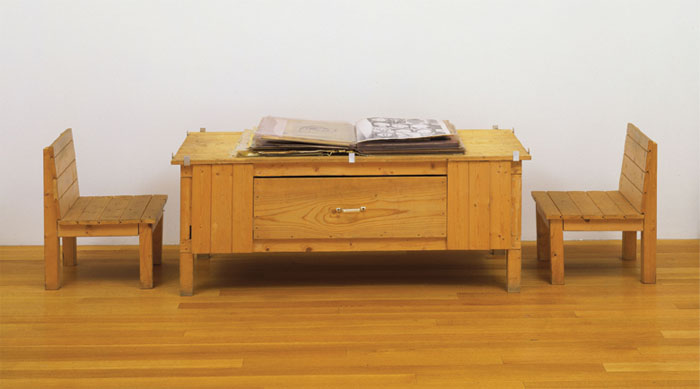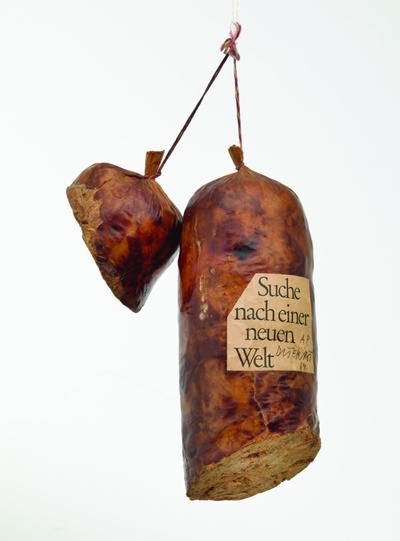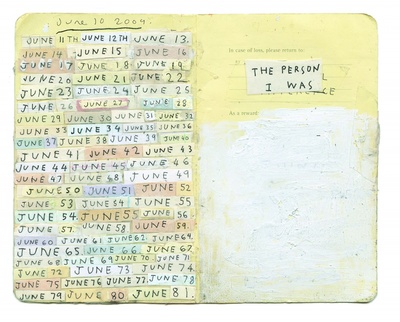The Book Is Dead

Dieter Roth, Snow, 1964/69, artist’s book of mixed mediums, with wood table and two wood chairs. The Museum of Modern Art, New York. Committee on Painting and Sculpture Funds. Photo: John Wronn. © 2013 Estate of Dieter Roth.
Rumors of the demise of the book have been greatly exaggerated, to paraphrase Mark Twain. As content goes increasingly digital, the death of the codex form has been predicted for at least the last two decades. Strikingly parallel with this protracted death, exaggerated or not, the field of artists’ books has flourished as never before.
It would be easy to argue that the rise of the contemporary artist’s book is a reaction against the increasing digitization of the world of words. Indeed, in many ways, this is true. But the rise in digital content has created a culture that’s comfortable with a saturation of words, ideas, and information—the kind of comfort level it takes to look at and appreciate artists’ books.
The entire notion of what may be defined as a book has been upended. No longer is it a bound block of printed pages. The physicality and beauty of artists’ books—their distinctive form—serves to explore content that ranges from political to personal, from arcane to universal, from banal to earthshaking. What artists’ books have in common with their traditional counterparts, generally, is to serve as vehicles for a story (though rarely a conventional narrative), to reflect on contemporary culture, and to frame history and memory.
Exhibitions of artists’ books or bookish art are content-rich and often text-driven. They demand extended attention, and a willingness to read, and to turn pages where actual pages exist. When In Retrospect: Artists’ Books by Maureen Cummins, Ann Lovett, and Nava Atlas began its tour in 2010, I worried about audience engagement with our books and related wall pieces, which are not only full of text, but present challenging themes. My concerns proved baseless, as students and public alike took the time to examine, peruse, and reflect. Ann Kalmbach, executive director of Women’s Studio Workshop (Rosendale, New York) offered a plausible theory as to why audiences engage so readily with artists’ books: We’re all trained early in our lives to digest words, and in the book arts, the use of text leads to greater comprehension of the images, as well as appreciation of the concept as a whole. Even in artists’ books more sculptural than text-driven, there’s a layering of ideas, and such works may be pondered long after a painting, or other image-only medium, has been encountered.
This year has seen a number of significant exhibitions in New York and New England featuring artists’ books and bookish subjects. An exhibition of Ed Ruscha’s seminal books, notably his Twentysix Gasoline Stations (1962), and the legions of photographic books inspired by him were featured at the uptown branch of Gagosian Gallery. Ruscha’s examples of cheaply printed, affordable (at the time) editions were clearly recognized as books, if “unorthodox” ones. At the other end of the spectrum, the Museum of Modern Art recently mounted Wait, Later This Will Be Nothing: Editions by Dieter Roth. Roth was a pioneer in total subversion of the book form, with influential works such as Literature Sausage, a pulped book mixed with onions and spices and stuffed into a sausage skin.

Dieter Roth, Literature Sausage (Literaturwurst), 1969, published 1961–70, artist’s book of ground copy of Halbzeit by Martin Walser, gelatin, lard, and spices in natural casing, 12 x 611⁄16 x 39⁄16″ (30.5 x 17 x 9 cm). Publisher and fabricator: the artist. Edition: artist’s proof before the edition of 50. The Museum of Modern Art, New York. The Print Associates Fund in honor of Deborah Wye. Photo: Thomas Griesel. © 2013 Estate of Dieter Roth.
Increasingly, artists’ books or book-like objects inform exhibitions, as was recently the case of Day After Day: The Diaristic Impulse at the University Art Museum at Albany. The capturing of memory and daily experience was evident in a number of media, but the inclusion of a moleskin notebook installation, artists’ sketchbook pages, a concertina book, and yes, an actual (though eccentric) diary gave this exhibition a bookish flavor. Photo-Rapide: François Deschamps at the Samuel Dorsky Museum at SUNY-New Paltz featured Deschamps’s stunning wall installations of portraiture influenced by the Malian tradition. Displayed alongside them were several of Deschamps’s impressive photographic books conveying his yearlong immersion in Mali.
Creating handmade or limited edition books is a gentle subversion of the mass-produced book model associated with the publishing industry. Of course, the use of digital tools to craft artists’ books is a gentle subversion as well. While many book artists treasure and preserve age-old techniques such as letterpress and traditional printmaking, others embrace new technology. Archival inkjet printers and computerized layout programs live side by side with their age-old counterparts, or they are sometimes used in tandem.
Finally, while the traditional book is being tested by the rise of e-books, this challenge is fueling a mini-renaissance in the appreciation of the finely made codex as an object of value and beauty. At the same time, book artists are deconstructing the traditional definition of “book.” At the center of this transformation and redefinition is the urgent desire to spend time with words, images, and ideas on paper, and to gain a restorative experience away from the screens and devices that dominate our daily lives.
My interview with Vicky and Bill Stewart of Vamp & Tramp Booksellers, preeminent dealers of contemporary artists’ books, provides an overview of the field. When Vicky and Bill, a corporate VP and a lapsed high school English teacher, began Vamp & Tramp in 1995, they were not aware of artists’ books. Today, they represent over 400 contemporary fine presses and book artists and spend most of the year traveling around the U.S., showing the books they represent to private and institutional collectors. This interview was conducted on April 19, 2013.
NA: Are fine editions distinctly different from artists’ books, or do the two fields overlap? If so, in what way?
V&T: Artists’ books are works of art realized in book form, and the connection to bookness is often tenuous and debatable. The boundary between fine press and artists’ books is ambiguous, but they’re connected by their fundamental insistence on the physical object. For us, fine press books are those in which the physical book—the paper, the printing, the arrangement of words and image on the page—honor the text. They are mostly codex in format. They are books my parents would recognize as books.
Artists’ books push the definition and concept of bookness. Our personal and comfortably ambiguous sense of artists’ books is this: Artists’ books begin with a sense of the book—that passive, practical, and elegant container for storing and retrieving story and information—and then they push that envelope. The physical book is no longer just the container for a story or information. With artists’ books, the physical aspects of the book become an expressive component of the aesthetic experience, on par with story, information, image. With artists’ books, to rephrase Barry Lopez’s elegant metaphor, it’s as if the goblet becomes the wine.
NA: At first glance, it seems that women are dominant in the phenomenon of making artists’ books. Though the field is hardly gender exclusive, do you observe a female dominance in this medium?
V&T: If you look only at the artists and presses represented by Vamp & Tramp, admittedly a small and biased selection, it’s true that women represented outnumber men. Our suspicion is that this is so for economic reasons. Few people are making a living from their artists’ books; no one is getting rich.
Most book artists need a patron to support their work. It can be a spouse, but more often than not it is the artists/printers themselves. They work at another job to pay their rent, buy food, and raise a family, but use some of those earnings to support their own art practice. Men are less secure about working in a relatively low-paid job. Women, for a host of painful reasons, are used to being underpaid and more willing to acquiesce to that circumstance. (Or perhaps they have a different idea than men of what constitutes value.)
NA: When did you start seeing exponential growth in the artists’ book field?
V&T: The interest in artists’ books is strong and continuing to grow. As with any significant growth, the process is tortuous, but it’s easy to look at 2007 as a significant year. That year through the efforts of Peter Koch and Susan Filter the Codex Foundation was born. Its goal is “to preserve and promote the hand-made book as a work of art in the broadest possible context and to bring to public recognition the artists, the craftsmanship, and the rich history of the civilization of the book.”
In February, 2007, the Codex Foundation in Berkeley, California, orchestrated a gathering of international fine presses and book artists. It was a resounding success, and that biennial Symposium and Book Fair has continued to grow, with more presses/artists represented and more attendance by the public. Moreover, the Codex Foundation now has two international branches: Codex Mexico and Codex Australia. A year later, the College Book Arts Association was born. It is an organization of higher-education institutions that “supports and promotes academic book arts education by fostering the development of its practice, teaching, scholarship and criticism.”

Simon Evans, Diary (detail), 2009, paper, moleskin notebook, invisible tape, correction fluid, pen. From the exhibition, Day After Day: The Diaristic Impulse at the University Art Museum, University at Albany, February 5 through April 6, 2013, curated by Corinna Ripps Schaming.
NA: How do you explain this most recent growth and interest in the field of artists’ books?
V&T: Our guess is this is a reaction to the virtual world that is the double-edged sword of modern life. Most of us spend time each day in some sort of virtual environment. The benefits are unquestionable, but it’s a bittersweet world. For the most part, contemporary artists’ books resist virtualization. Most insist on hands-on experience. Artists’ books remind us that even virtual reality is a substitute for, or alternative to, material reality. The material world is bittersweet, too, but to deny or avoid it seems to leave a void. Artists’ books help fill that void. In these days when screens are replacing paper at an operatic rate, artists’ books resist the onslaught. Artists’ books defy translations into other media, be they catalogues, two-dimensional images, or video. The physical artifact is essential to the experience. Take away the physical and you’ve not only gutted the experience, but turned the cadaver into a ghost of itself.
Nava Atlas is a visual artist specializing in limited edition books with themes of gender bias and social justice. Her work is part of numerous academic and museum collections of artists books around the country. She is also the author of traditionally published nonfiction. Her work can be seen at navaatlasart.com.
BOOK ARTS ORGANIZATIONS AND COLLECTIONS IN NEW ENGLAND AND NEW YORK
Bill and Vicky Stewart of Vamp & Tramp pinpoint 2007 as a turning point in the growth of artists’ books. The 1960s and 70s were another fertile period, seeing the formation of several institutions continuing today, and listed below.

Antonia Aitken, artist-in-residence, came to Women’s Studio Workshop in the fall of 2012 to edition her artist’s book Drawing the Step.
Photo courtesy of Women’s Studio Workshop.
ORGANIZATIONS
Printed Matter, Inc.
Founded in 1976, this is “the world’s largest nonprofit organization dedicated to the promotion of publications by artists.…Printed Matter’s mission is to foster appreciation, dissemination, and understanding of artists’ publications, which we define as books or other editioned publications conceived by artists as art works, or more succinctly ‘artwork for the page.’” Set up as a retail establishment in NYC’s Chelsea gallery district, Printed Matter sells publications produced in inexpensive editions, book arts, or book objects. printedmatter.org
The Center for Book Arts
This organization is “dedicated to preserving traditional artistic practices of bookmaking, as well as exploring and encouraging contemporary interpretations of the book as an art object.” Its program areas include exhibitions, lectures, services for artists, and a wide offering of classes, encompassing bookbinding, letterpress printing, papermaking, and other book-related arts. The Center for Book Arts is located just beyond NYC’s Chelsea gallery district.
centerforbookarts.org
Women’s Studio Workshop
Founded in 1974 by four women artists, WSW (Rosendale, NY) has long been “committed to developing an alternative space for artists to create new work and share skills…centered on the artistic process and often informed by feminist values.” Its current focus is on artists’ grants, residencies, a summer art institute, and internships. WSW maintains a significant collection of artists’ books by women, and no less than eight academic repositories for the editions produced there, three of which—RIT, Vassar, and Yale—in the Northeast. Hands, Voice, & Vision, featuring artists’ books created at WSW over thirty years, has been touring since its launch at NYC’s Grolier Club in 2010.
wsworkshop.org/archive_search.php
Booklyn Artists Alliance
Predictably located in Brooklyn, Booklyn is one of the newer organizations promoting the book arts and related practices. Part of its mission is to help artists “document, exhibit, and distribute their artwork and provide the general public and educational institutions with services and programs involving contemporary artists’ publications and works on paper.” Booklyn produces and curates exhibitions for museums, libraries, universities, and other sites, and “provides support for artwork that deals with provocative subject matter including environmental, historical, linguistic, and political issues.”
booklyn.org
PROMINENT ARTISTS’ BOOK COLLECTIONS IN NEW ENGLAND AND NEW YORK
Connecticut
University of Connecticut, Storrs
Dodd Research Center
doddcenter.uconn.edu/asc/collections/artistsbooks/artistsbooks.htm
Wesleyan University, Middletown
Olin Library
wesleyan.edu/libr/schome
Yale University Library, New Haven
Arts of the Book Collection
library.yale.edu/arts/specialcollections/index.html
Massachusetts
Harvard University, Boston
Fine Arts Library
hcl.harvard.edu:8001/libraries/finearts/collectionsartists_books.cfm
Smith College, Northampton
Neilson Library, Mortimer Rare Book Room
smith.edu/libraries/libs/rareboo/collections
Wellesley College, Boston
Art Library
new.wellesley.edu/lts/collections/speccoll/bookarts
Rhode Island
RISD, Providence
Fleet Library
library.risd.edu/special-collections.html
Vermont
University of Vermont, Burlington
Bailey/Howe Library, Special Collections
library.uvm.edu
New York
Skidmore College, Saratoga Springs
Lucy Scribner Library, Digital Collections
lib.skidmore.edu/artistsbooks
Vassar College, Poughkeepsie
Poughkeepsie Art Library
artlibrary.vassar.edu/Collections.html#artistsbooks
SELECTED NONACADEMIC PROGRAMS FOR PRACTITIONERS OF ALL LEVELS
In addition to the Center for Book Arts and Women’s Studio Workshop, listed above, there are many nonacademic programs for learning book art skills (binding, printing, letterpress, etc.) at all levels. A representative sampling includes:
AS 220
as220-shop.myshopify.com/collections/workshops-printshop/products/book-structures
Garage Annex School for Book Arts
garageannexschool.com
University of Southern Maine
usm.maine.edu/summer/book-arts#3
Wells College Book Arts Summer Institute
wells.edu/pdfs/book-arts/WellsBookArtsBrochure2013.pdf
Women’s Studio Workshop Summer Arts Institute
wsworkshop.org/program/art-classes-workshops/2013-summer-art-institute
